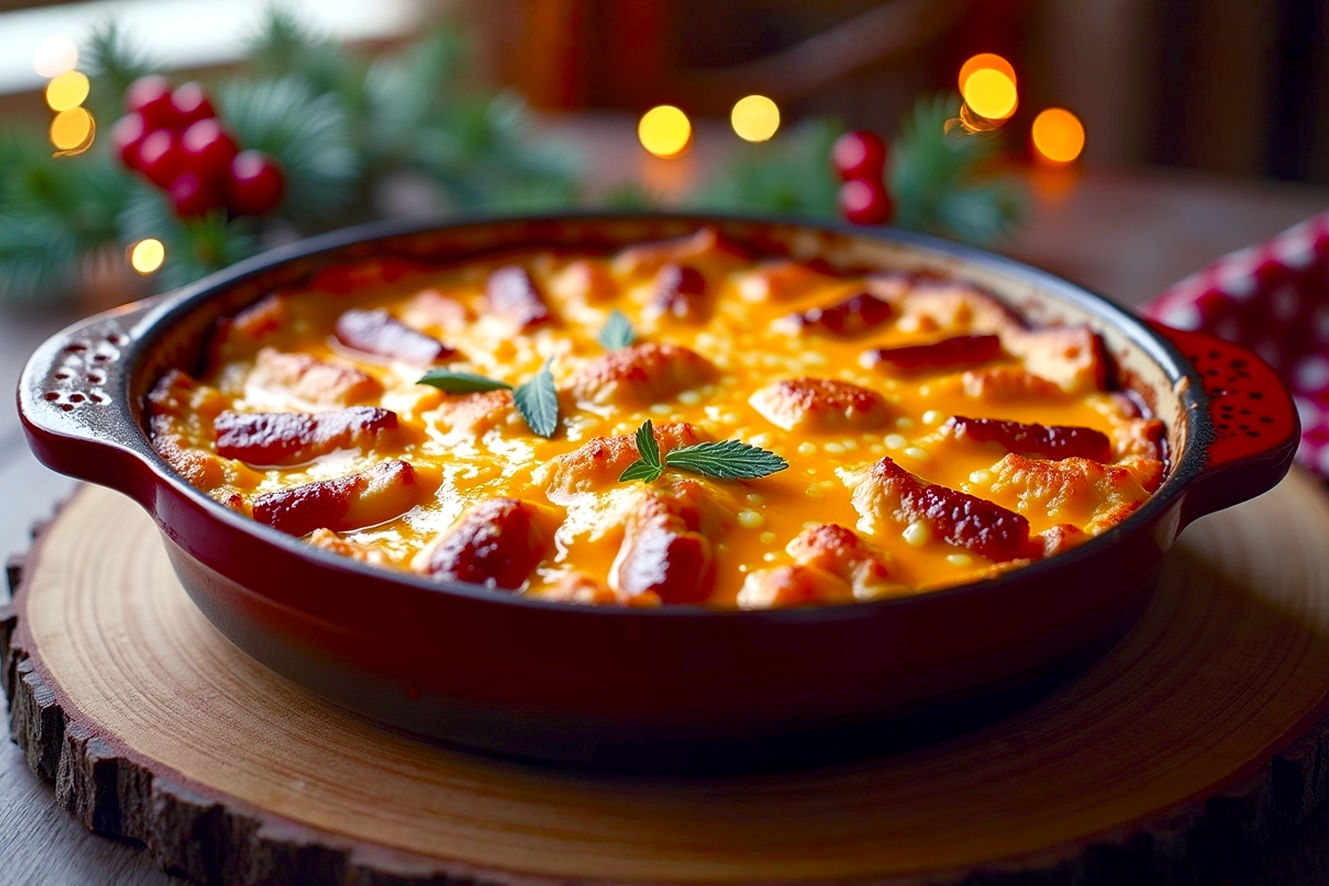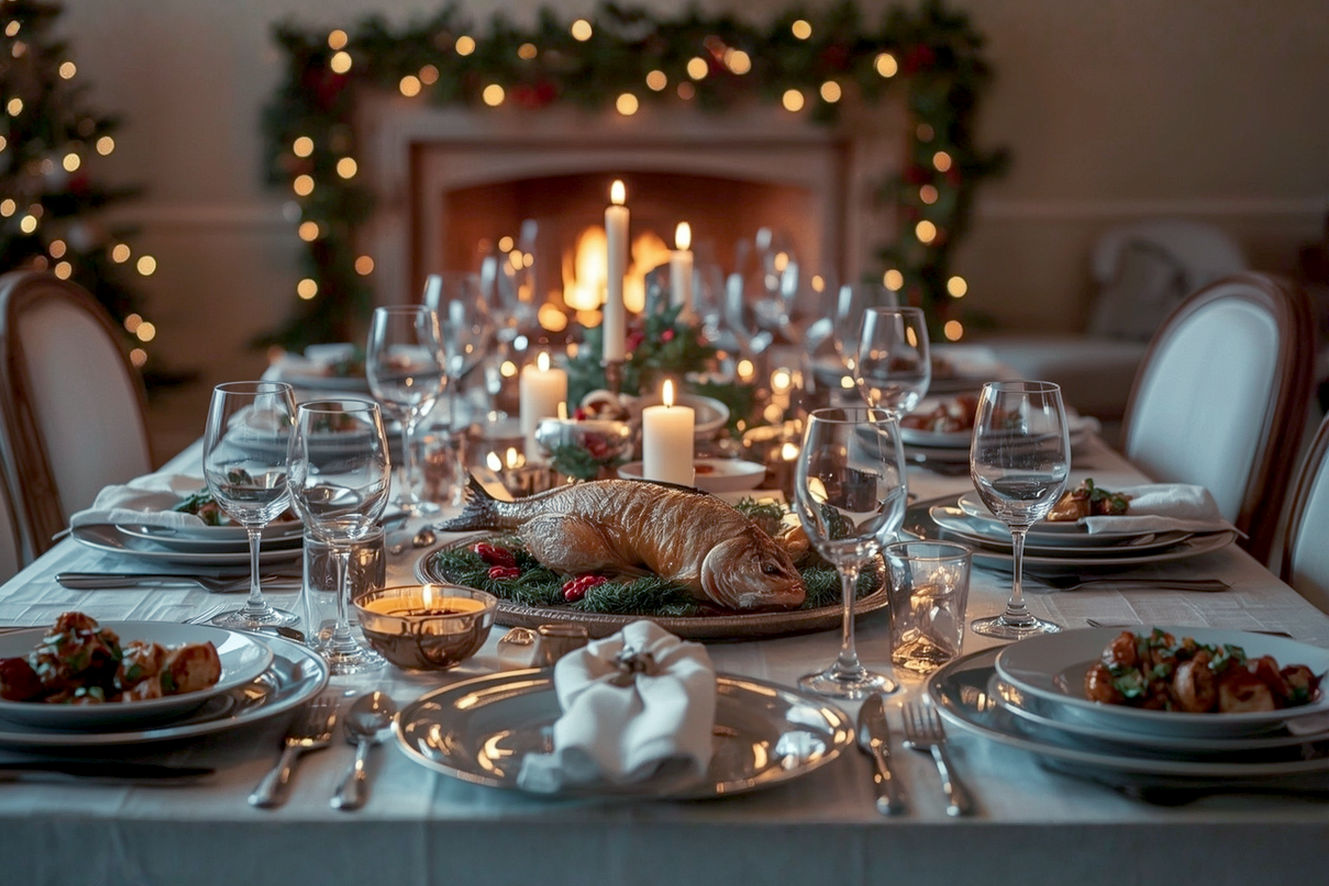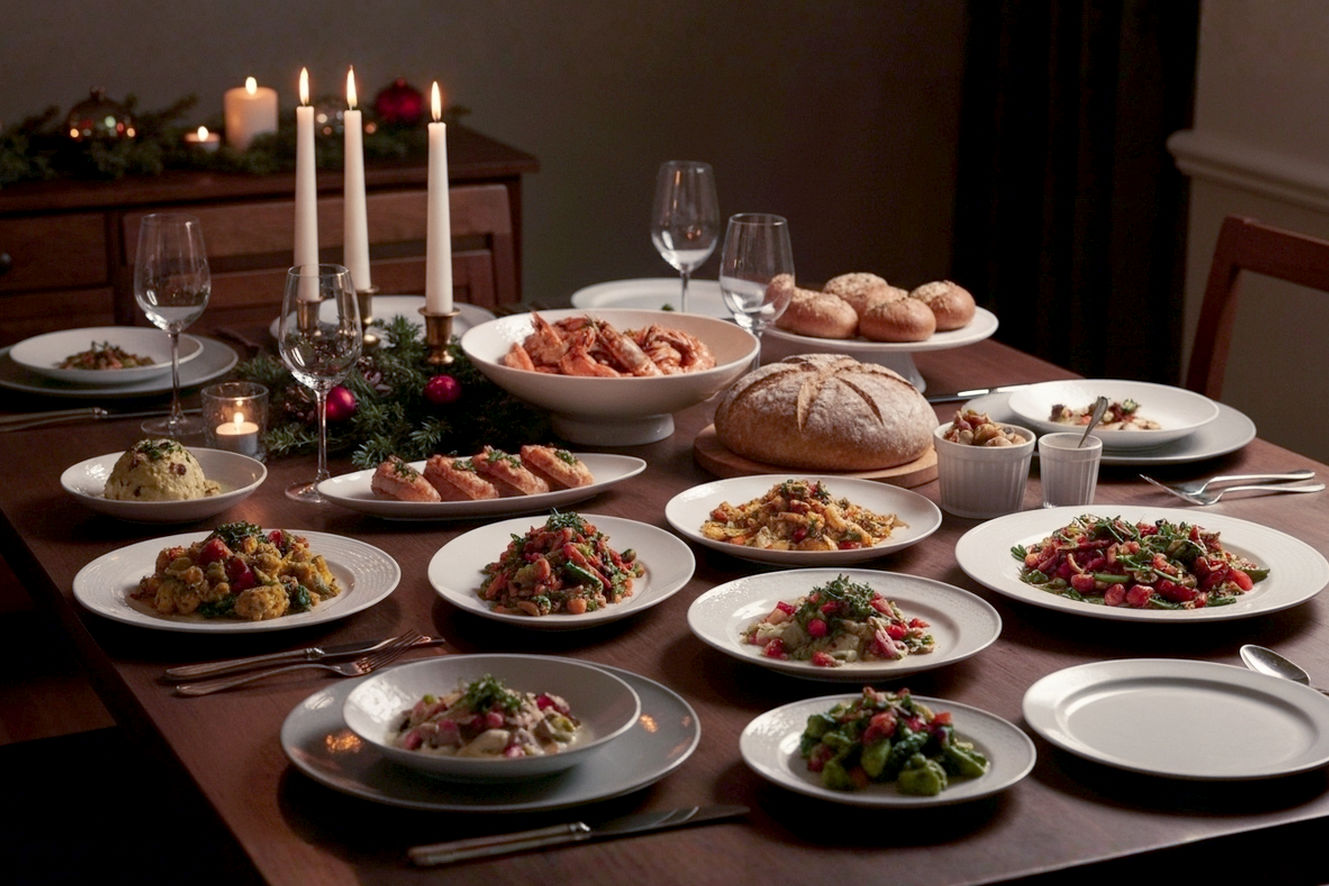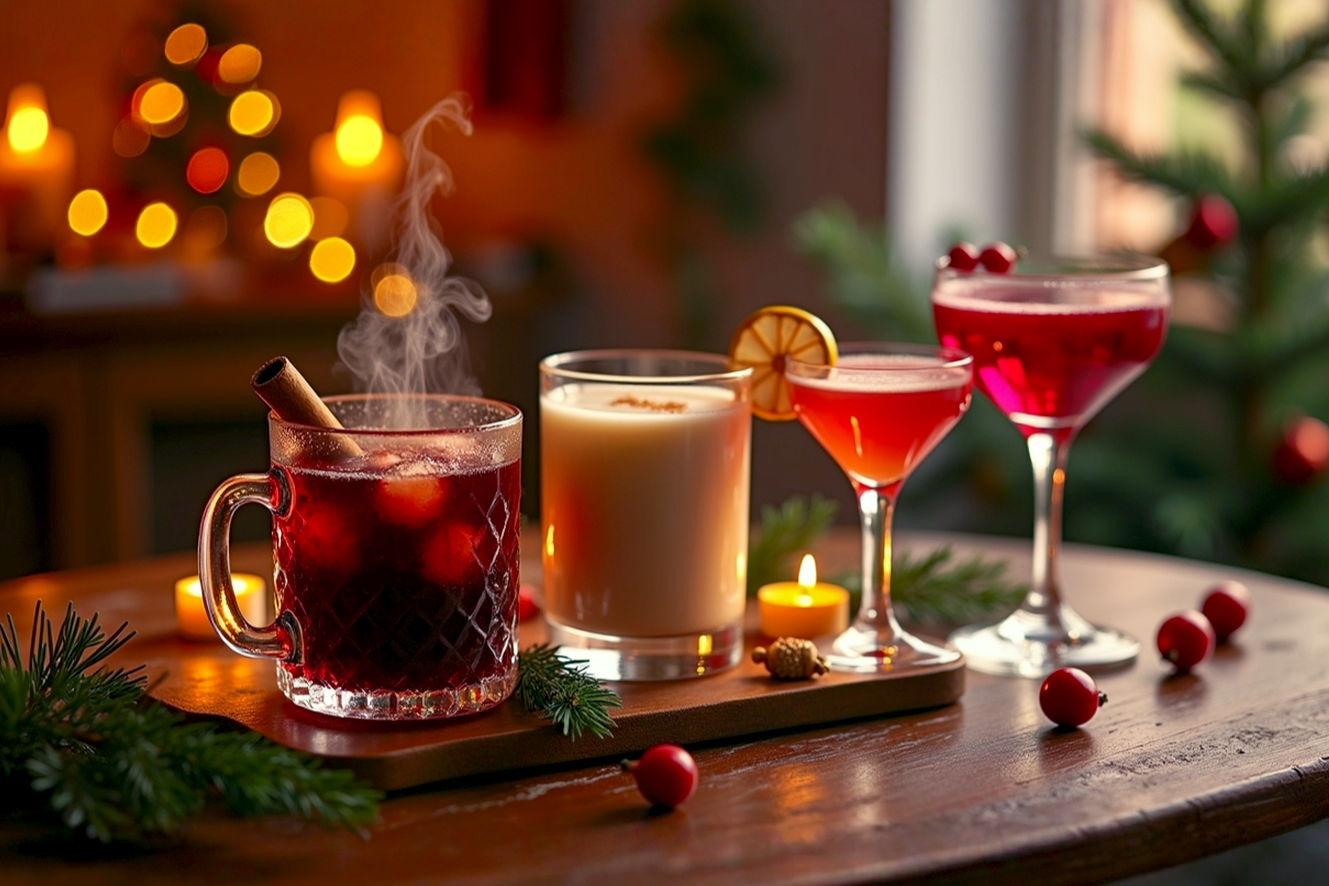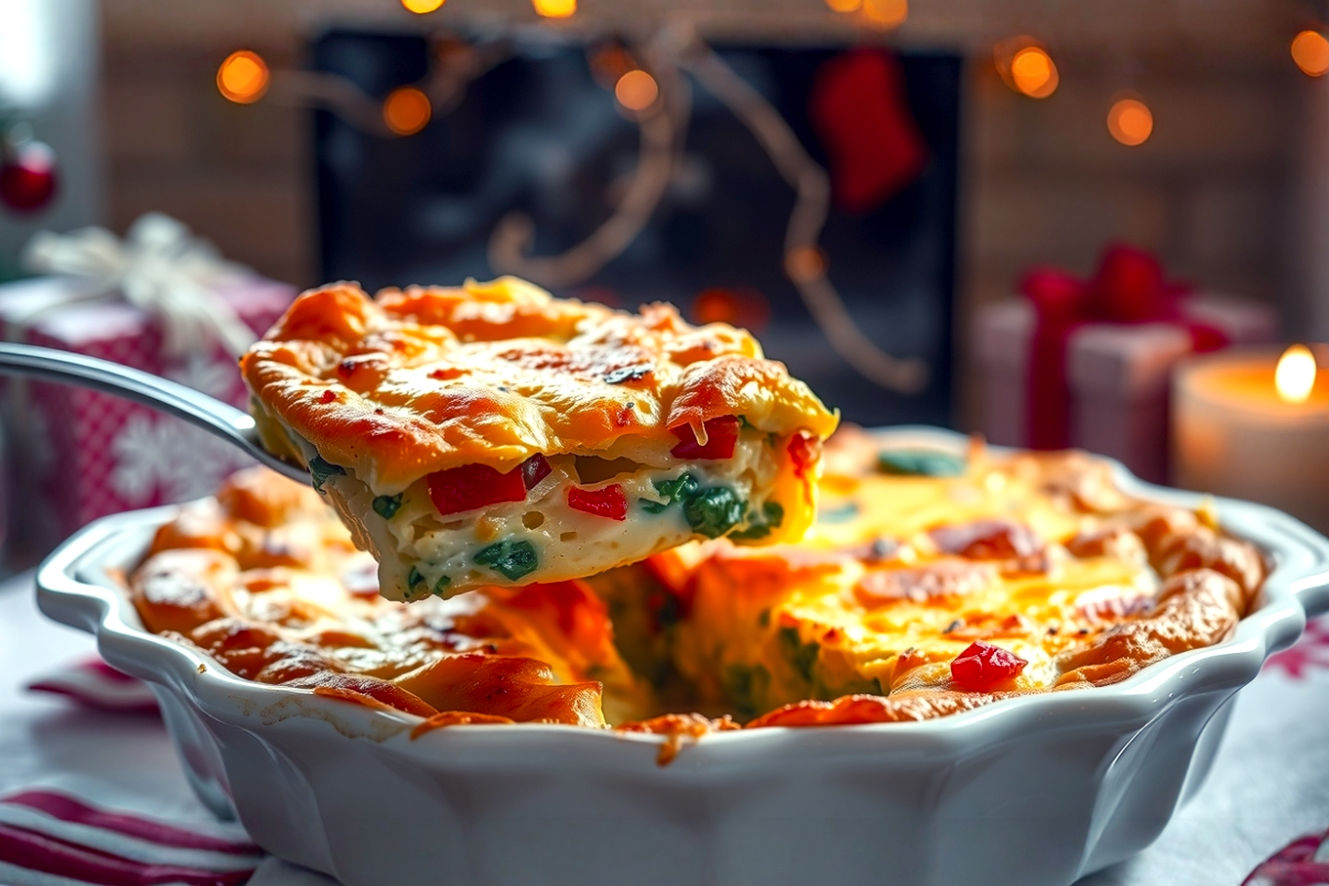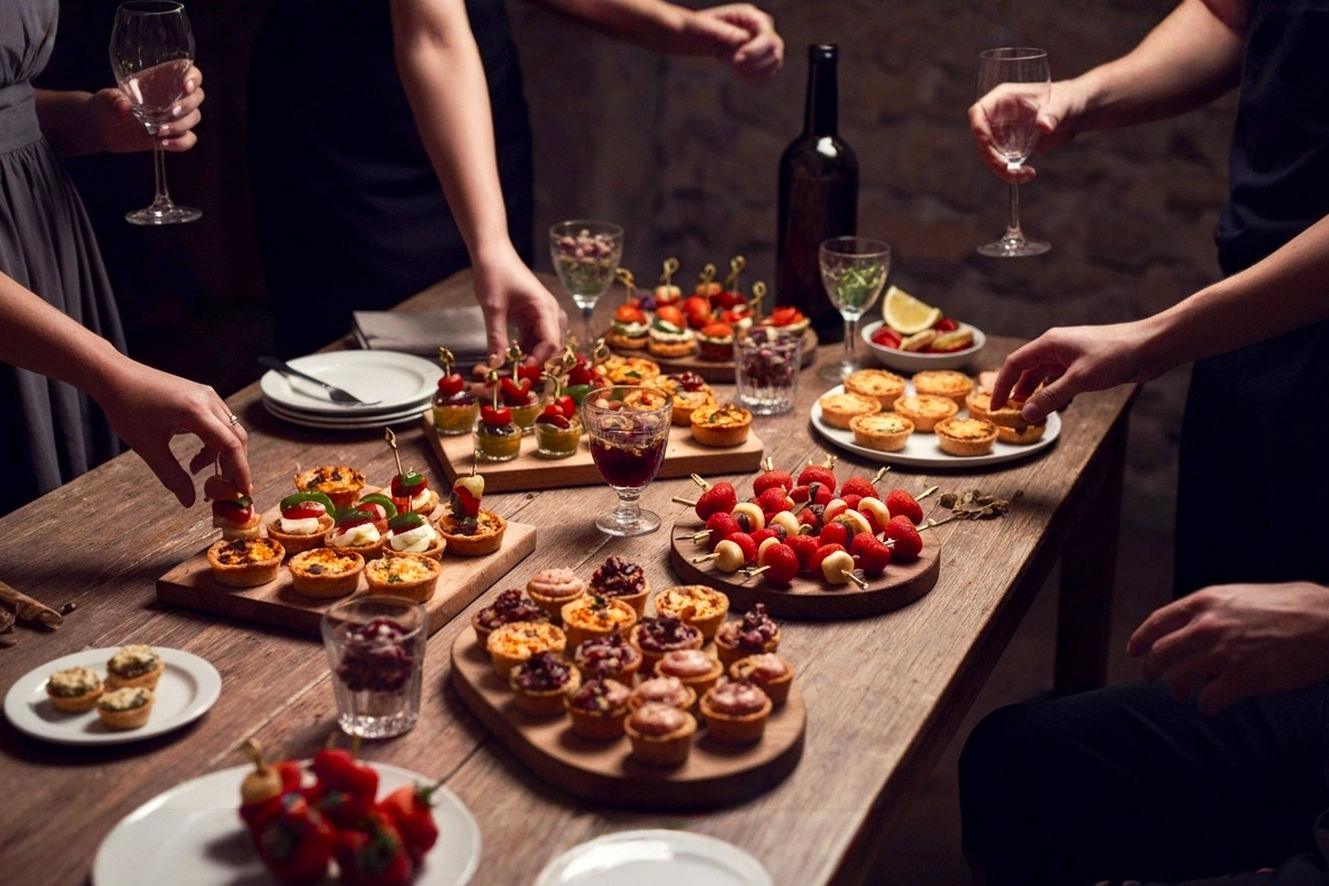This post may contain affiliate links. If you make a purchase through these links, we may earn a commission at no additional cost to you.
Introduction: The Global Tapestry of Christmas Eve Dinner
Christmas Eve, the night before Christmas Day, holds a special place in holiday traditions around the world. While Christmas Day often features grand feasts, Christmas Eve dinner can be just as significant, if not more so, in many cultures. It’s a time when families gather, often sharing meals that are deeply rooted in history, religion, and local customs. These dinners aren’t just about the food; they’re about connection, anticipation, and the unique ways different communities celebrate the start of the Christmas season.
More Than Just a Meal: A Time for Tradition and Family
For many, Christmas Eve dinner is a cherished ritual, a moment to slow down amidst the holiday rush and truly connect with loved ones. It’s a time for storytelling, laughter, and strengthening family bonds. The specific dishes served often carry generations of meaning, passed down from grandparents to parents to children. These meals are a tangible link to the past, reminding us of where we come from and the traditions that define us. It’s a moment of shared heritage, whether it’s a quiet, intimate supper or a boisterous, extended family gathering.
The Evolving Nature of Christmas Eve Celebrations
While tradition is central, Christmas Eve dinners aren’t static. They evolve over time, adapting to new influences, dietary preferences, and modern lifestyles. For instance, some families might blend traditional recipes with contemporary twists, or incorporate dishes from different cultural backgrounds. The availability of ingredients, changing family structures, and even global migration patterns can all shape what ends up on the Christmas Eve table. What was once a strict religious observance might now be a more secular family celebration, but the core idea of gathering and sharing remains.
The Historical Roots of Christmas Eve Feasts
Understanding Christmas Eve dinner means looking back at its origins. Many of the customs we see today are shaped by centuries of religious practice and ancient winter celebrations.
Fasting and Feasting: Religious Observances
Historically, Christmas Eve was often observed as a day of fasting, particularly in Catholic traditions. This fast, known as “Vigilia” (or Vigil), was a period of abstinence from meat in preparation for the birth of Christ on Christmas Day. The idea was to purify the body and soul before a major religious feast. Because meat was forbidden, fish and vegetables became the staples of the Christmas Eve meal. This is why, even today, many cultures, especially those with strong Catholic roots, feature seafood prominently on December 24th. The fast would typically end at midnight, leading into a more elaborate, meat-inclusive meal on Christmas Day.
Pre-Christian Winter Solstice Influences
Before Christianity became widespread, many cultures celebrated the winter solstice, the shortest day of the year. These pagan festivals often involved feasting, light, and rituals to welcome the return of longer days. As Christianity spread, many of these existing traditions were absorbed and adapted into Christian holidays. Elements like evergreens, lights, and communal meals found their way into Christmas celebrations, including Christmas Eve. The act of gathering and sharing food during the darkest time of the year has deep, ancient roots, symbolizing hope and community.
The Shift from Fasting to Festive Meals
Over time, the strictness of the Christmas Eve fast began to loosen in many regions. While the tradition of abstaining from meat persisted in some areas, the meal itself became more elaborate and celebratory. Instead of a meager fast, it transformed into a special, often fish-centric, feast. This shift reflected a broader change in societal customs, where religious observances became intertwined with cultural festivities. The focus moved from strict penance to joyful anticipation, with the meal serving as a bridge between the solemn vigil and the joyous celebration of Christmas Day.
North American Christmas Eve Dinner Traditions
North America, particularly the United States and Canada, is a melting pot of cultures, and Christmas Eve dinner traditions reflect this diversity. While there isn’t one single “typical” meal, several prominent customs stand out.
United States: A Melting Pot of Customs
In the U.S., Christmas Eve dinner can vary wildly from one household to another, often depending on family heritage. Some families might have a casual meal, while others observe elaborate, multi-course feasts.
The Feast of the Seven Fishes: An Italian-American Staple
Perhaps the most well-known and distinctive Christmas Eve dinner tradition in the United States is the Feast of the Seven Fishes. This elaborate, meatless meal is a cornerstone for many Italian-American families, especially in the Northeast. It’s a grand culinary event, often spanning several hours and featuring a wide array of seafood dishes.
Origins and Significance of the Seven Fishes
The Feast of the Seven Fishes, or “Festa dei Sette Pesci” in Italian, is a tradition brought to America by immigrants from Southern Italy. Its roots lie in the Catholic custom of abstaining from meat on the vigil before major feast days. The “seven” fishes are symbolic, though the exact meaning can vary. Some believe it represents the seven sacraments, the seven virtues, or the seven days of creation. The number seven is also frequently mentioned in the Bible. While the number of dishes is traditionally seven, many families prepare even more, sometimes nine, eleven, or thirteen, reflecting other significant numbers in Christian tradition. The core idea is to enjoy a bountiful meal of fish before the meat-centric Christmas Day.
Common Dishes in the Feast
The specific dishes in the Feast of the Seven Fishes can differ by family and region, but some are almost always present. Baccalà (salted cod) is a ubiquitous element, often prepared fried, baked, or stewed. Other popular choices include fried calamari (squid), shrimp scampi (shrimp sautéed in garlic butter), clams or mussels in white wine sauce, fried smelts (small fish), baked or grilled octopus, and various types of pasta with seafood sauce, such as linguine with clam sauce. Side dishes might include simple vegetables, bread, and perhaps some light desserts like struffoli (honey balls) or panettone. The preparation is often a multi-day affair, with families gathering to clean, chop, and cook together, making the process as much a part of the tradition as the eating itself.
Other Regional American Christmas Eve Meals
Beyond the Feast of the Seven Fishes, American Christmas Eve dinners are incredibly diverse.
Southern Comforts and Holiday Spices
In the American South, Christmas Eve dinner might lean towards comfort foods with a holiday twist. This could include ham or turkey, often served with classic Southern sides like collard greens, cornbread dressing, sweet potato casserole, and biscuits. The flavors are rich and hearty, reflecting the region’s culinary heritage. Some families might also feature seafood, but it’s less about a strict “seven fishes” rule and more about incorporating local favorites like shrimp and grits or fried catfish. Desserts often include pecan pie or red velvet cake.
Midwestern Potlucks and Family Gatherings
Midwestern Christmas Eve dinners often revolve around large family gatherings, sometimes in a potluck style where everyone brings a dish. The food tends to be comforting and substantial, designed to feed a crowd. Common dishes might include roast beef or pork loin, various casseroles (like green bean casserole or cheesy potato casserole), mashed potatoes with gravy, and a variety of salads. The emphasis is on warmth, togetherness, and hearty food that can be easily shared. These meals often serve as a prelude to a larger, more formal Christmas Day dinner.
Canada: Diverse Influences on Christmas Eve
Canada’s Christmas Eve traditions are similarly varied, influenced by its multicultural population, particularly its strong French and British roots.
French-Canadian Réveillon: A Late-Night Feast
In Quebec and other French-speaking parts of Canada, Christmas Eve is marked by Le Réveillon, a grand, late-night feast that often begins after midnight mass. This is a truly significant meal, often more elaborate than Christmas Day dinner. Traditional dishes include tourtière (a savory meat pie, often pork or beef), ragout de boulettes (meatball stew), pâtés, and various cured meats. Desserts are plentiful, with bûche de Noël (Yule log cake) being a popular choice. The Réveillon is a joyous, extended celebration, filled with food, drink, and lively conversation, sometimes lasting into the early hours of Christmas morning.
British and European Echoes in Canadian Celebrations
Across other parts of Canada, Christmas Eve dinner might be a more modest affair, often influenced by British or other European traditions. Many families opt for a lighter meal, saving the main feast for Christmas Day. This could involve fish and chips, a simple roast chicken, or pasta dishes. However, some families with strong European ties might incorporate specific dishes from their heritage, such as perogies for those of Eastern European descent or fish dishes for those with Italian or Portuguese backgrounds. The evening often focuses on opening one small gift, attending church services, and preparing for the next day’s festivities.
European Christmas Eve Dinner Customs
Europe is a mosaic of Christmas Eve dinner traditions, each country and even region boasting its own unique customs and culinary delights.
Italy: La Vigilia and Beyond
As mentioned, Italy is the origin of the Feast of the Seven Fishes, known as La Vigilia (The Vigil). While the Italian-American version is well-known, the tradition in Italy itself is incredibly diverse, varying significantly from north to south.
Regional Variations in Italian Christmas Eve Dinners
Southern Italy’s Seafood Extravaganza
In Southern Italy, particularly regions like Campania, Calabria, and Sicily, the Christmas Eve meal is very much a seafood extravaganza, reflecting the historical Catholic tradition of abstaining from meat. Similar to the Feast of the Seven Fishes, these meals feature a wide variety of fish and shellfish. Baccalà (salted cod) is a staple, often fried, baked, or stewed with tomatoes and olives. Other common dishes include fritto misto di mare (mixed fried seafood), spaghetti alle vongole (spaghetti with clams), octopus salad, and various fried vegetables. The meal is typically lighter than the Christmas Day feast but still abundant, emphasizing the freshness of local ingredients.
Northern Italy’s Meat-Focused Feasts
Interestingly, in Northern Italy, the Christmas Eve meal can be quite different. While some families still observe the meatless tradition, many have shifted towards more meat-centric or richer dishes. This might include tortellini in brodo (small pasta in broth), cappelletti, or other types of stuffed pasta. Roasted meats like capon (a castrated rooster) or veal might also appear. The influence of the Alps and Central European culinary traditions is more evident here, often leading to heartier, warming dishes. Desserts like panettone and pandoro are universally enjoyed across Italy.
France: Le Réveillon de Noël
In France, Christmas Eve is celebrated with Le Réveillon de Noël, a sophisticated and often luxurious late-night dinner, similar to the French-Canadian tradition. This meal is a culinary highlight of the holiday season.
Oysters, Foie Gras, and Bûche de Noël
The French Réveillon is renowned for its gourmet offerings. Appetizers often include fresh oysters, delicate foie gras (duck or goose liver pâté), and smoked salmon. The main course might feature capon or turkey stuffed with chestnuts, lobster, or scallops. Rich sauces and exquisite side dishes accompany these mains. The meal culminates with the iconic Bûche de Noël (Yule log cake), a sponge cake rolled and decorated to resemble a log, symbolizing the log burned on Christmas Eve in ancient traditions. Fine wines and champagne flow freely throughout the evening, adding to the festive atmosphere. The meal is a testament to French culinary artistry, designed for indulgence and celebration.
The Grandeur of a French Christmas Eve
The French Christmas Eve dinner is not just about the food; it’s about the entire experience. It’s a formal affair, often dressed up, with elegant table settings and meticulous presentation. Families gather, sometimes after attending midnight mass, and the meal can last for several hours, extending well into the early morning. It’s a time for refined conversation, enjoying exquisite flavors, and celebrating in style. The grandeur of the Réveillon sets the tone for a festive Christmas Day.
Germany: Simple Suppers and Festive Preparations
In Germany, Christmas Eve (Heiligabend) is often a more intimate and somewhat quieter affair, especially compared to the elaborate Christmas Day feast. The focus is on family time and the anticipation of Christmas morning.
Kartoffelsalat und Würstchen: A Classic German Meal
A very common and traditional Christmas Eve dinner in Germany is surprisingly simple: Kartoffelsalat und Würstchen (potato salad and sausages). This humble meal allows families to spend more time together, opening presents and preparing for Christmas Day, rather than hours cooking. The potato salad can be made with mayonnaise or a vinegar-based dressing, and the sausages are typically frankfurters or wiener sausages. This simple meal reflects a desire for ease and togetherness on a night dedicated to family and reflection.
The Anticipation of Christmas Day
While the dinner might be simple, the evening itself is filled with excitement. Many German families open their presents on Christmas Eve, often after dinner or after attending a church service. The atmosphere is cozy and warm, with the Christmas tree lit and carols playing. The modest meal serves as a calm prelude to the more substantial and celebratory Christmas Day dinner, which typically features a roast goose or duck with elaborate side dishes.
United Kingdom: A Quieter Affair Before the Main Event
In the United Kingdom, Christmas Eve is generally a more relaxed evening, with the main culinary focus reserved for Christmas Day. The dinner is often lighter and less formal.
Light Meals and Festive Snacks
Many British families opt for a relatively light dinner on Christmas Eve. This could be anything from a simple fish and chips takeaway, a pizza, or a light pasta dish. Some might have a traditional Christmas buffet with party food, including sausage rolls, mini quiches, and various dips. The emphasis is on ease and spending time together, perhaps watching a Christmas movie or playing board games. Children often leave out milk and cookies for Santa and a carrot for his reindeer.
The Build-Up to Christmas Day Dinner
The evening is all about building anticipation for Christmas Day. Stockings are hung, last-minute preparations are made, and families settle in for a cozy night. While there isn’t a specific traditional Christmas Eve dinner, the atmosphere is distinctly festive. The main event, the roast turkey or goose dinner with all the trimmings, is eagerly awaited for Christmas Day.
Spain: Nochebuena and Traditional Dishes
In Spain, Christmas Eve, known as Nochebuena (Good Night), is a major family celebration, often more significant than Christmas Day itself. It’s a time for large gatherings and lavish meals.
Pavo Trufado de Navidad and Seafood Delights
The Nochebuena dinner is typically a grand affair, starting late in the evening and often lasting past midnight. A traditional main course might be Pavo Trufado de Navidad (Christmas turkey stuffed with truffles), though this is less common now. More frequently, the meal features an abundance of seafood, including prawns, langostines, crab, and baked fish like sea bream or hake. Cordero asado (roast lamb) or cochinillo asado (roast suckling pig) are also popular, especially in certain regions. Appetizers often include jamón serrano (cured ham), cheeses, and various tapas.
Turrón and Polvorones for Dessert
Dessert is a crucial part of the Spanish Nochebuena, with a focus on traditional sweets. Turrón, a nougat confection made with almonds, is a must-have, available in various textures (hard and soft). Other popular sweets include polvorones (crumbly shortbread cookies) and mantecados (lard cakes). The meal is accompanied by plenty of wine and cava (Spanish sparkling wine), and families often sing carols (villancicos) after dinner.
Poland: Wigilia – A Meatless, Twelve-Dish Feast
Poland observes Wigilia, a deeply traditional and symbolic Christmas Eve dinner. It is a meatless feast, reflecting the Catholic vigil, and is one of the most important family meals of the year.
The Significance of the Twelve Dishes
The Wigilia dinner traditionally consists of twelve meatless dishes, symbolizing the twelve Apostles or the twelve months of the year. No meat is consumed, and often no dairy or eggs either, making it a truly Lenten meal. The meal begins only after the first star appears in the night sky, symbolizing the Star of Bethlehem. Before eating, families share opłatek (a thin, unleavened wafer), breaking off a piece for each person and exchanging good wishes. An empty place setting is often left at the table for an unexpected guest or for those who have passed away.
Common Wigilia Dishes: Barszcz, Pierogi, and Karp
Key dishes in a Polish Wigilia include barszcz (clear red beet soup), often served with uszka (small mushroom-filled dumplings). Pierogi (dumplings) are essential, typically filled with sauerkraut and mushrooms, or sometimes potatoes and cheese. Karp (carp) is the traditional fish, often fried or jellied. Other dishes might include herring prepared in various ways (in oil, cream, or vinegar), bigos (hunter’s stew, but meatless for Wigilia), kutia (a sweet grain pudding with poppy seeds, honey, and nuts), and kompot z suszu (a dried fruit compote). The meal is a rich tapestry of flavors and textures, each dish carrying its own cultural significance.
Scandinavia: Julbord and Specific Traditions
In Scandinavia, Christmas Eve is the primary day for celebration, with a focus on family and a festive meal often centered around a “Julbord” (Christmas table) or similar spread.
Sweden: Julbord’s Array of Delicacies
In Sweden, Christmas Eve dinner is usually a Julbord, a smorgasbord-style buffet featuring a wide range of traditional dishes. While a full Julbord might be served throughout the Christmas season, a smaller, more focused version is common on Christmas Eve. Key elements include various types of pickled herring, gravlax (cured salmon), smoked salmon, and Janssons frestelse (Jansson’s temptation, a creamy potato and anchovy casserole). Julskinka (Christmas ham) is also central, alongside köttbullar (meatballs), prinskorv (small sausages), and ribs. The meal is accompanied by glögg (mulled wine) and julmust (a soft drink similar to root beer). The evening often includes watching “Kalle Anka” (Donald Duck Christmas specials) and the arrival of Jultomten (Santa Claus).
Norway and Denmark: Similar Yet Distinct Celebrations
Norway and Denmark share many similarities with Sweden but have their own specific Christmas Eve dinner traditions. In Norway, common main courses include ribbe (pork ribs) or pinnekjøtt (salted, dried, and sometimes smoked lamb ribs). Lutefisk (lye-treated dried fish) is also a traditional, though acquired taste. In Denmark, flæskesteg (roast pork with crackling) and andesteg (roast duck) are popular choices, often served with caramelized potatoes and red cabbage. Both countries enjoy risengrød (rice porridge) or risalamande (rice pudding with almonds and cherry sauce) for dessert, with a hidden almond often determining who gets a small prize.
Latin American Christmas Eve Dinner Celebrations
Latin America’s Christmas Eve traditions are vibrant and deeply rooted in family and faith, often featuring grand, late-night feasts.
Mexico: Nochebuena with Tamales and Bacalao
In Mexico, Nochebuena is a huge celebration, often involving large family gatherings and a lavish dinner. The meal is typically served late, sometimes after attending “Misa de Gallo” (Midnight Mass).
Culinary Staples of a Mexican Christmas Eve
Traditional Mexican Christmas Eve dinner features a variety of rich and flavorful dishes. Tamales are a staple, filled with various meats (pork, chicken) or cheese and chilies, steamed in corn husks. Bacalao a la Vizcaína (salted codfish stew) is a very popular dish, especially in central Mexico, reflecting Spanish influence. Other common foods include romeritos (a dish made with seepweed, mole sauce, and dried shrimp), pavo (roasted turkey), and ensalada de Nochebuena (Christmas Eve salad), which is a colorful salad with beets, apples, nuts, and sometimes jicama.
The Role of Ponche Navideño
The meal is often accompanied by Ponche Navideño, a warm, spiced fruit punch made with fruits like tejocotes (Mexican hawthorn), guavas, apples, and prunes, sweetened with piloncillo (unrefined whole cane sugar) and spiced with cinnamon sticks. The atmosphere is joyous, with music, dancing, and fireworks often continuing into the early hours of Christmas morning.
Brazil: Ceia de Natal – A Grand Affair
Brazil’s Ceia de Natal (Christmas Supper) is another grand, late-night feast, reflecting the country’s diverse cultural heritage.
Turkey, Cod, and Tropical Fruits
The Brazilian Christmas Eve dinner is a lavish spread, often featuring a mix of traditional European and local influences. Chester (a specific type of plump chicken) or peru (roasted turkey) are common main dishes, often served with farofa (toasted cassava flour mixture) and rice. Bacalhau (salted codfish), a legacy of Portuguese influence, is also very popular, prepared in various ways like bacalhau com natas (cod with cream). Side dishes include elaborate salads, potato dishes, and a wide array of tropical fruits like mangoes, papayas, and grapes, which are abundant during the Brazilian summer Christmas.
The Late-Night Celebration
The meal typically begins late in the evening, often around 10 PM or later, and families exchange gifts at midnight. The celebration is lively, with music, dancing, and fireworks. Desserts include rabanadas (Brazilian French toast), panettone, and various puddings. The Ceia de Natal is a true family affair, bringing together multiple generations for a night of feasting and joyous celebration.
Other Latin American Countries: Shared and Unique Customs
Many other Latin American countries share similar Christmas Eve dinner customs, often featuring a blend of indigenous ingredients and European traditions. In Peru, roasted turkey or chicken is common, alongside arroz árabe (Arabian rice) and puré de manzana (apple sauce). In Venezuela, the hallaca is the star – a corn dough tamale filled with a stew of beef, pork, and chicken, wrapped in plantain leaves. Pan de jamón (ham bread) is another Venezuelan staple. Across the region, the emphasis is on large family gatherings, abundant food, and late-night celebrations that extend into Christmas Day.
Asian and Oceanic Christmas Eve Dinner Practices
While Christmas is not a traditional holiday in many Asian countries, Christian communities and Western influences have led to unique Christmas Eve dinner customs. In Oceania, the summer climate significantly shapes the celebrations.
Philippines: Noche Buena – A Grand Family Reunion
The Philippines, with its strong Catholic heritage, celebrates Noche Buena (Christmas Eve) with immense enthusiasm, making it one of the most important family gatherings of the year.
Lechon, Pancit, and Fruit Salad
The Noche Buena feast is a lavish spread, often prepared throughout the day and served at midnight after families attend Simbang Gabi (night masses). The centerpiece is often lechon (whole roasted pig), a crispy, succulent dish that is a symbol of celebration. Other popular dishes include pancit (noodles, symbolizing long life), hamon (Christmas ham), queso de bola (Edam cheese), and sweet spaghetti (a Filipino-style spaghetti with hot dogs and a sweet tomato sauce). A refreshing fruit salad made with canned fruit cocktail, cream, and condensed milk is a common dessert.
The Festive Atmosphere
The Noche Buena is a time for families to reunite, often with relatives traveling long distances. The atmosphere is incredibly festive, filled with music, laughter, and fireworks. Gifts are exchanged at midnight, and the feasting continues into the early hours of Christmas morning, making it a truly memorable and joyous occasion.
Australia and New Zealand: Summer Christmas Feasts
In Australia and New Zealand, Christmas falls during the summer, which significantly influences Christmas Eve dinner traditions. The focus shifts from heavy, warming meals to lighter, cooler options.
Barbecues and Seafood in the Southern Hemisphere
While some families might still opt for a traditional roast, many embrace the warm weather with barbecues on Christmas Eve. This could involve grilling sausages, steaks, and seafood like prawns (shrimp) and fish. Fresh seafood platters are incredibly popular, featuring oysters, prawns, and crab. Salads, cold meats, and fresh fruits are also common. The meal is often enjoyed outdoors, perhaps in the backyard or at a beach.
Adapting European Traditions to a Warm Climate
Despite the warm climate, there’s still an influence from European traditions. Some families might have a lighter version of a traditional roast, or incorporate elements like pavlova (a meringue-based dessert with fruit and cream) for dessert, which is well-suited to summer. The evening often involves last-minute gift wrapping, decorating, and enjoying the long summer twilight before Christmas Day.
Common Themes and Variations in Christmas Eve Dinners
Despite the vast differences in specific dishes and customs, several common themes emerge when looking at Christmas Eve dinners globally.
The Role of Fasting and Abstinence
The historical practice of fasting before a major feast day, particularly in Christian traditions, has left a lasting legacy. Even in cultures where strict fasting is no longer observed, the tradition of a meatless or fish-centric meal on Christmas Eve persists. This often manifests as a focus on seafood, reflecting the historical need for alternatives to meat. This religious observance, while sometimes relaxed, underscores the spiritual preparation for Christmas.
Seafood as a Central Element
Following from the fasting tradition, seafood plays a remarkably central role in Christmas Eve dinners across many cultures. From the Feast of the Seven Fishes in Italy and the U.S. to bacalao in Mexico and Brazil, and various fish dishes in Poland and Scandinavia, fish and shellfish are prominent. This widespread use of seafood highlights a shared historical and religious influence that transcends geographical boundaries. The availability of fresh seafood also plays a role, with coastal regions naturally incorporating more aquatic fare.
The Importance of Family Gathering
Perhaps the most universal theme is the emphasis on family gathering. Christmas Eve dinner is almost always a time for loved ones to come together, often multiple generations under one roof. It’s a moment for connection, conversation, and strengthening familial bonds before the excitement of Christmas Day. This communal aspect is vital, making the meal much more than just sustenance; it’s a shared experience that reinforces family identity and belonging.
Desserts and Drinks: Sweet Endings and Festive Toasts
No Christmas Eve dinner is complete without special desserts and festive drinks. From the elaborate Bûche de Noël in France to the simple turrón in Spain, and the sweet kutia in Poland, desserts provide a celebratory end to the meal. Likewise, festive drinks, whether it’s wine, champagne, glögg, or ponche, add to the joyous atmosphere, facilitating toasts and good cheer. These elements contribute to the overall celebratory mood and provide a sweet conclusion to the evening’s feast.
Planning Your Own Christmas Eve Dinner: Tips and Ideas
Whether you’re looking to embrace a new tradition or refine an existing one, planning your Christmas Eve dinner can be a joyful process.
Embracing Tradition or Creating New Ones
You don’t have to be Italian-American to host a Feast of the Seven Fishes, nor do you need to be Polish to try Wigilia dishes. Christmas Eve is a wonderful opportunity to explore different cultural traditions and incorporate them into your own celebration. You might choose one or two dishes from a specific country that resonate with you, or you might decide to create an entirely new tradition unique to your family. The beauty of Christmas Eve is its flexibility and the personal meaning it holds. Don’t be afraid to experiment and find what feels right for your household.
Menu Planning and Preparation
Successful Christmas Eve dinner planning involves thoughtful menu selection and preparation. Consider the number of guests, their dietary preferences, and the time you have available for cooking. If you’re hosting a large gathering, a potluck style can ease the burden on one cook. For more elaborate meals, consider preparing some dishes in advance, such as chopping vegetables, making sauces, or even baking desserts a day or two before. This allows you to enjoy the evening more and spend less time in the kitchen during the celebration itself. A detailed timeline can help ensure everything is ready on time.
Dietary Considerations and Modern Adaptations
In today’s world, dietary considerations are more important than ever. When planning your Christmas Eve dinner, be mindful of any allergies, intolerances, or dietary choices (vegetarian, vegan, gluten-free) among your guests. Many traditional dishes can be adapted to suit these needs without sacrificing flavor or authenticity. For example, a meatless Wigilia is naturally vegetarian, and many seafood dishes are gluten-free. Modern recipes often offer creative substitutions, allowing everyone to enjoy the festive meal. Don’t hesitate to ask your guests about their dietary needs beforehand to ensure a comfortable and inclusive dining experience for all.
Conclusion: A World United by Festive Flavors
Christmas Eve dinner is a truly global phenomenon, a testament to the diverse ways humanity celebrates the holiday season. From the elaborate, seafood-laden tables of Southern Italy to the simple potato salad and sausages of Germany, and the vibrant, late-night feasts of Latin America, each tradition tells a unique story of culture, history, and faith. These meals are more than just food; they are expressions of identity, moments of shared joy, and anchors of family tradition.
The Enduring Spirit of Christmas Eve
What unites these disparate customs is the enduring spirit of Christmas Eve itself: a night of anticipation, reflection, and togetherness. It’s a time when the world seems to slow down, allowing families to connect on a deeper level before the excitement of Christmas Day. The food, whether humble or grand, serves as a focal point for these precious moments, creating memories that last a lifetime. The act of sharing a meal, breaking bread together, symbolizes unity and love, which are at the heart of the holiday season.
A Culinary Journey of Love and Togetherness
Ultimately, a typical Christmas Eve dinner looks like whatever a family makes it. It’s a culinary journey that can span continents and centuries, reflecting a rich tapestry of human experience. But at its core, it’s always about love, togetherness, and the shared joy of the holiday season. So, as you gather around your own table this Christmas Eve, take a moment to appreciate the global culinary heritage that enriches this special night, and savor the flavors that bring us all a little closer.

